December 2025
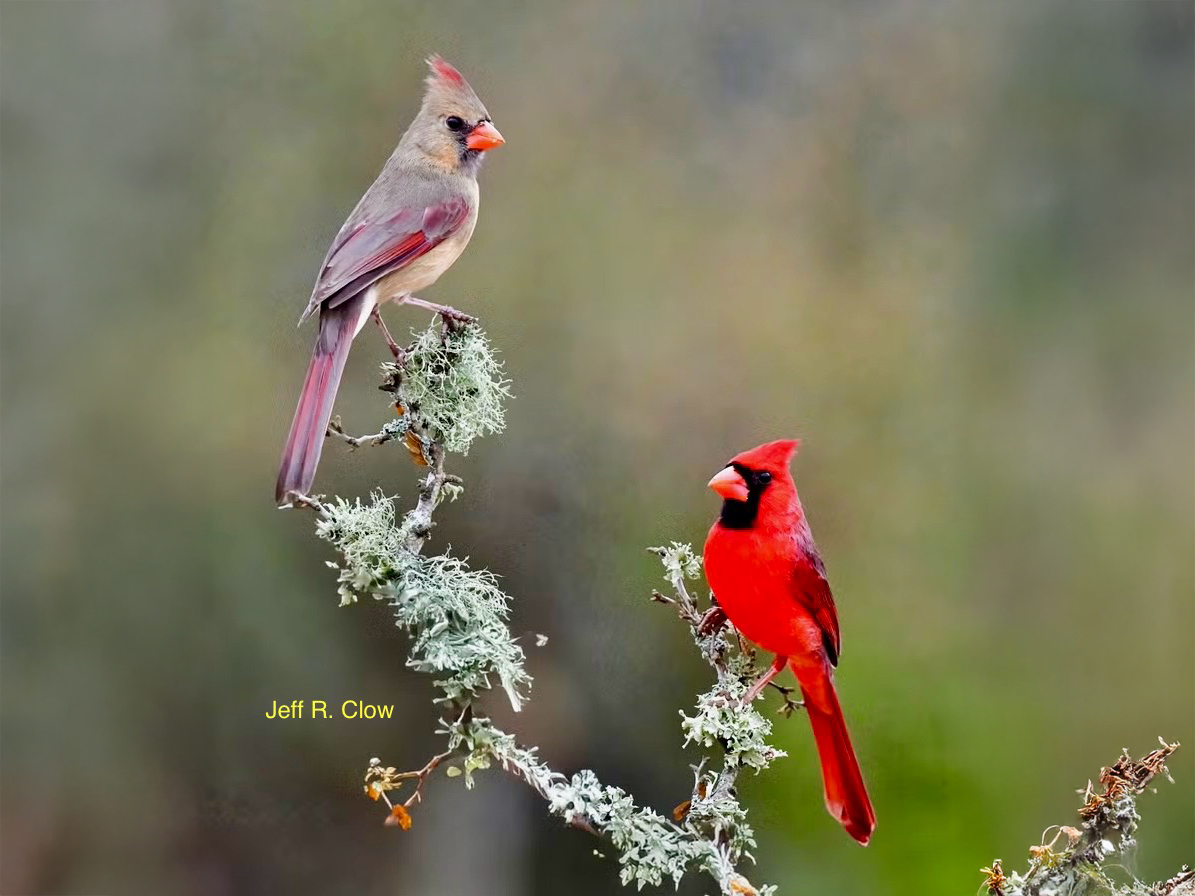

Cardinalis cardinalis
The Northern Cardinal is one of the most recognizable birds throughout the eastern US.
The males retain their beautiful bright red plumage throughout the winter. Females are a warm brown color with hints of red.
Cardinals do not migrate and are easily attracted to backyard seed feeders.
Female cardinals are one of the few female birds that sing
Both sexes will defend their territories by pecking their reflections in windows and mirrors.
November 2025
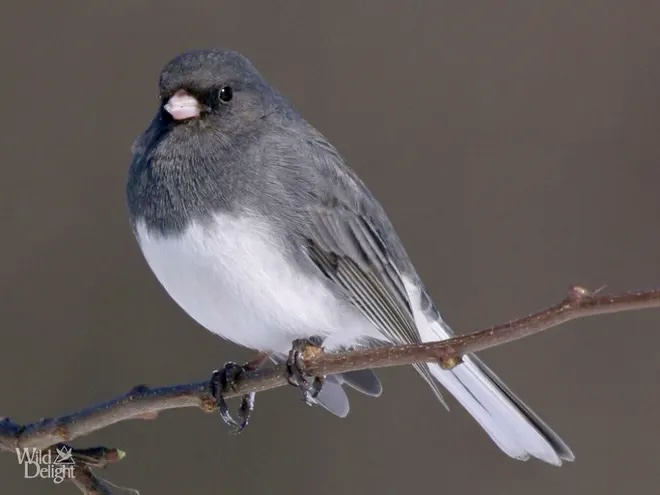
Junco hyemalis
During the winter months in the Appalachians, Dark-eyed Juncos come down from the higher elevations and spend time in the Hendersonville area.
These sparrows, sometimes called “snowbirds”, are found foraging on the ground, and will visit backyard seed feeders.
Our local juncos are gray and white, but in the western US they can be brown.
Look for juncos along the greenway at the edge of wooded areas. Notice a flash of white in their outer tail feathers as they fly.
October 2025
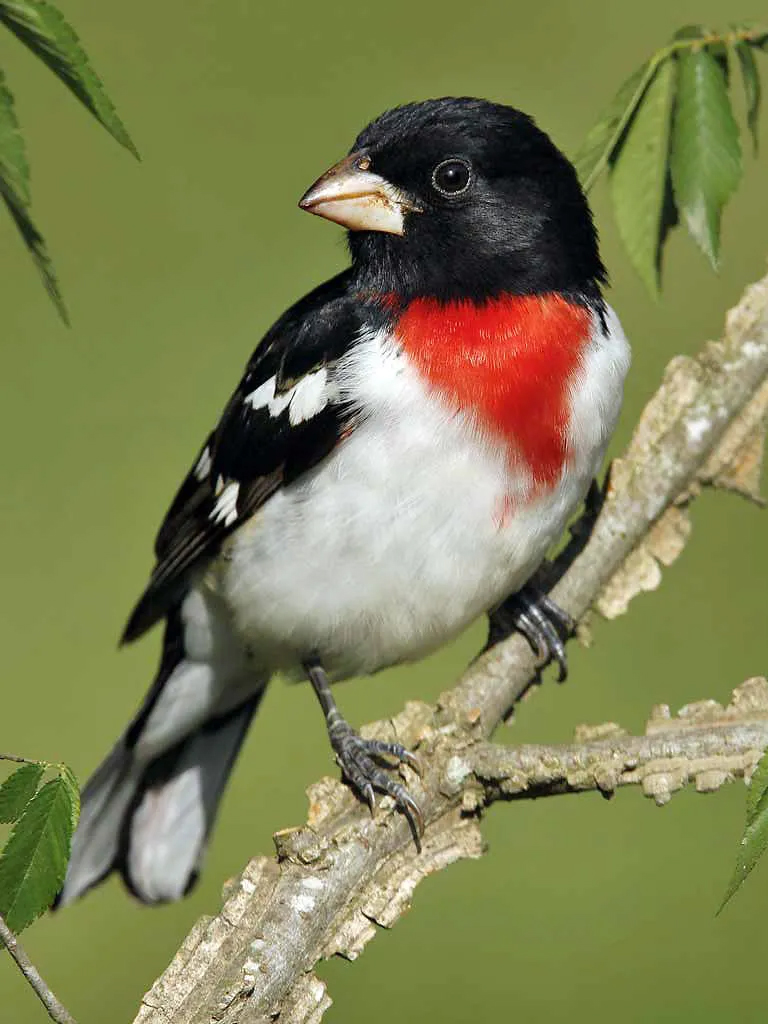
Pheucticus ludovicianus
Rose-breasted Grosbeaks are passing through our area, on their way to their wintering grounds in the Caribbean, and Central and South America.
Males are black and white with a bright red patch on their breasts. Females are streaked with brown and show a prominent white eyebrow.
They are found along the greenway at the forest edge, and will visit backyard seed feeders.
September 2025
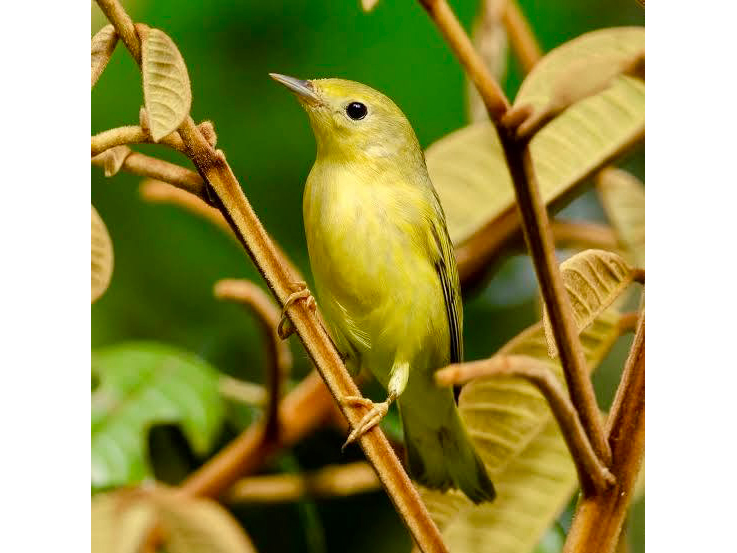
Setophaga petechia
September is the best month to view warblers in western NC, and the Yellow Warbler is always a welcome sight.
This species may be found gleaning insects lower in the trees and shrubs.
The underside of the bird is totally yellow in both males and females.
Look for them along the greenway, often with other migrating warblers, before they make their way south to Central and South America for the winter.
August 2025
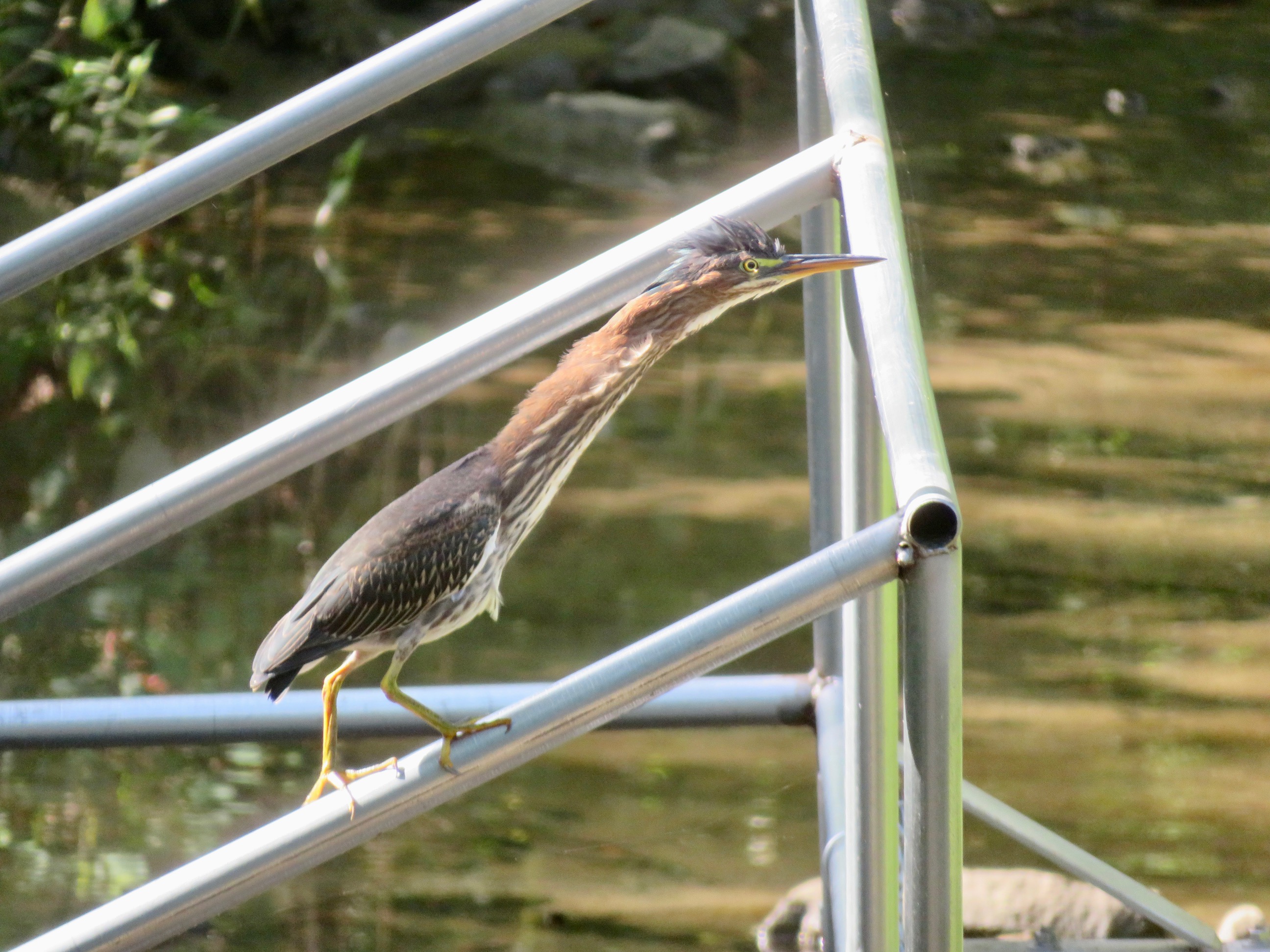
Butorides virescens
Observant visitors along the Greenway often spot the Great Blue Heron, standing tall and out in the open. But the Green Heron, which is smaller and less conspicuous, sometimes goes unnoticed.
Green Herons fish along the edge of the creek, often in the shadows. Their coloring of brown streaks and a dark green back make them more camouflaged.
This Green Heron was photographed along the greenway, on top of the trash trout, catching dragonflies.
July 2025

Cyanocitta cristata
Blue Jays are year-round birds found throughout the eastern US. They are large, noisy songbirds recognized by their blue plumage and prominent crests, and male and female Blue Jays look alike.
Blue Jays are found in neighborhoods and parks, and are easily attracted to back yard feeders. They prefer platform feeders with sunflower seeds or peanuts.
Known as Corvids, Blue Jays are in the same family as crows and are known for their intelligence. They are also very good at mimicking the calls of our local hawks.
June 2025
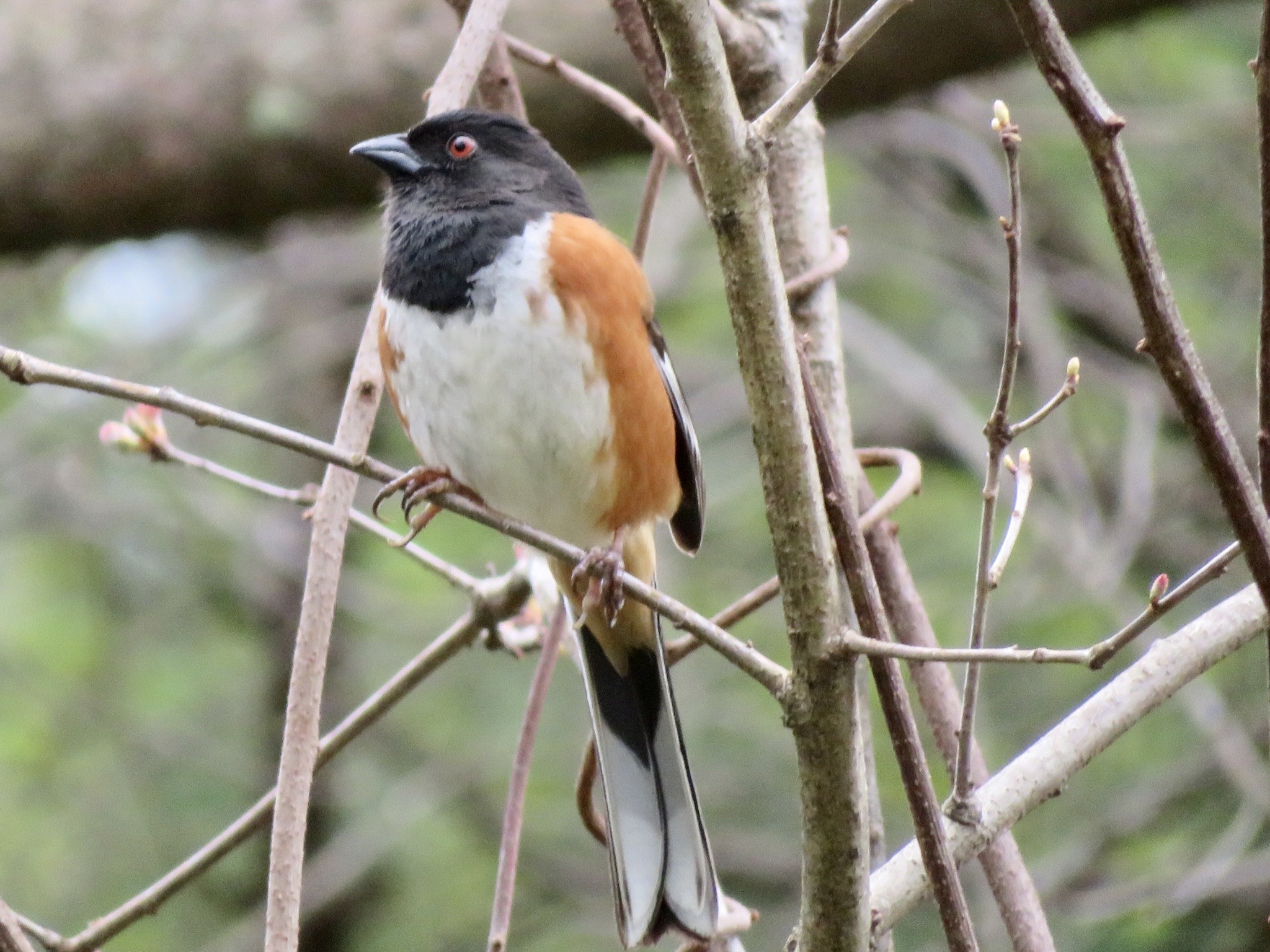
Pipilo erythrophthalmus
Eastern Towhees are large, colorful sparrows found year-round on the greenway. They usually stay low to the ground in thickets, and may be spotted flying across the greenway path.
Listen for their song which sounds like “Drink your tea,” or simply “Tow-weee.”
You can attract towhees to your yard by keeping some border areas overgrown. Towhees will scratch in the leaf litter for seeds, and eat fallen seeds from the bird feeders.
May 2025
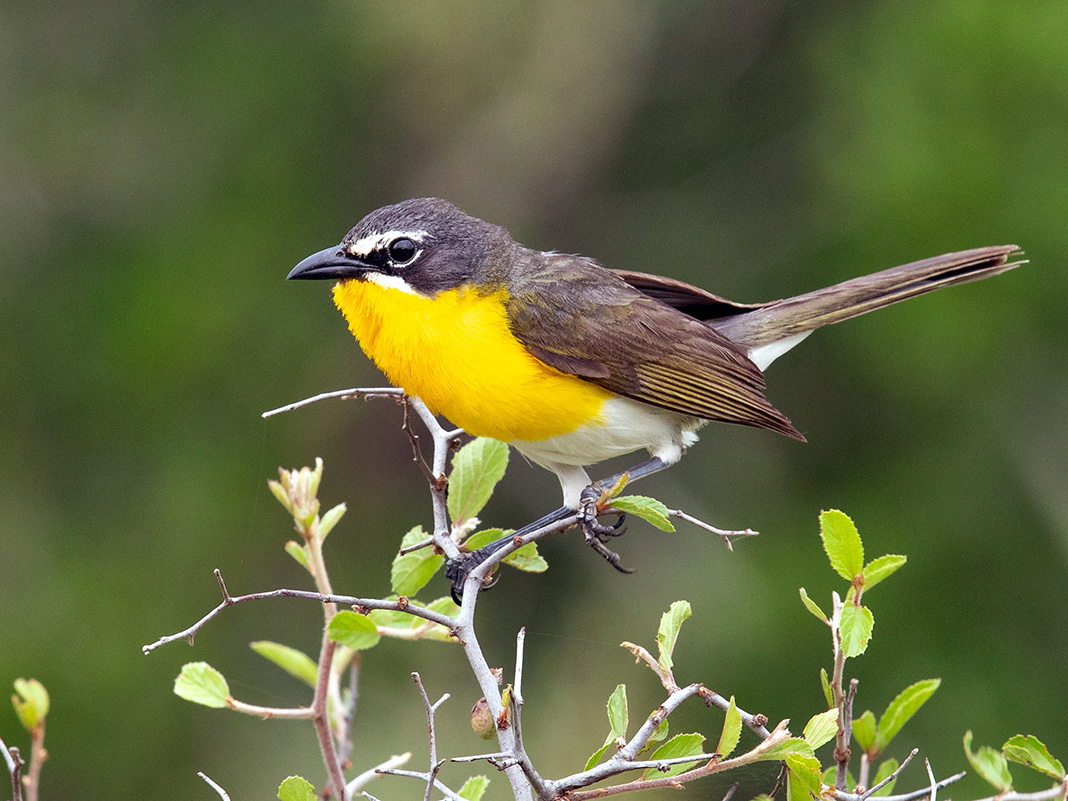
Icteria virens
Yellow-breasted Chats have returned to our area to breed, after spending the winter in South Florida and Central America.
Listen for singing males along the greenway in low thickets. Their song is an unusual series of whistles, rattles, grunts and other sounds.
With some patience you may be lucky enough to catch a glimpse of this songbird in the shrubby habitat along the trail.
April 2025
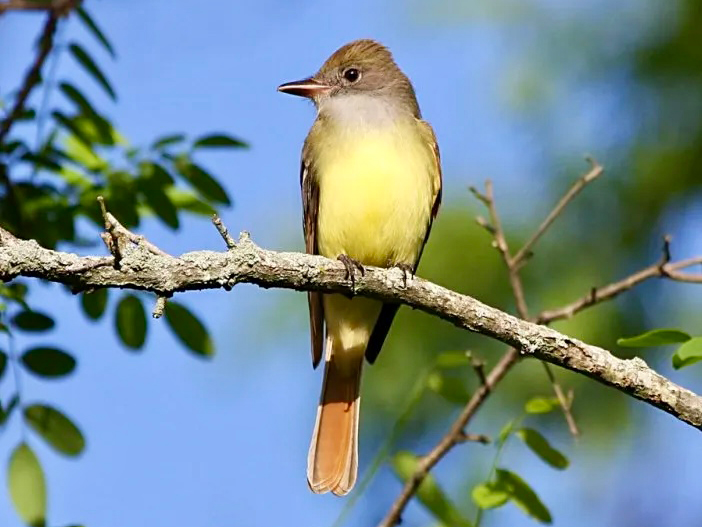
Myiarchus crinitus
In April many song birds return from the tropics, some staying here in western NC to breed and raise their young. The Great Crested Flycatcher will be returning to the wooded areas along the greenway.
This bird of the high tree tops is difficult to spot, but you may discover one by listening for a Wee-eep call. Look for a crested bird with a rufous tail and yellow belly.
Flycatchers eat insects on the wing so they will not visit feeders. However, you may attract them to your yard with a nesting box as they are cavity nesters.
March 2025
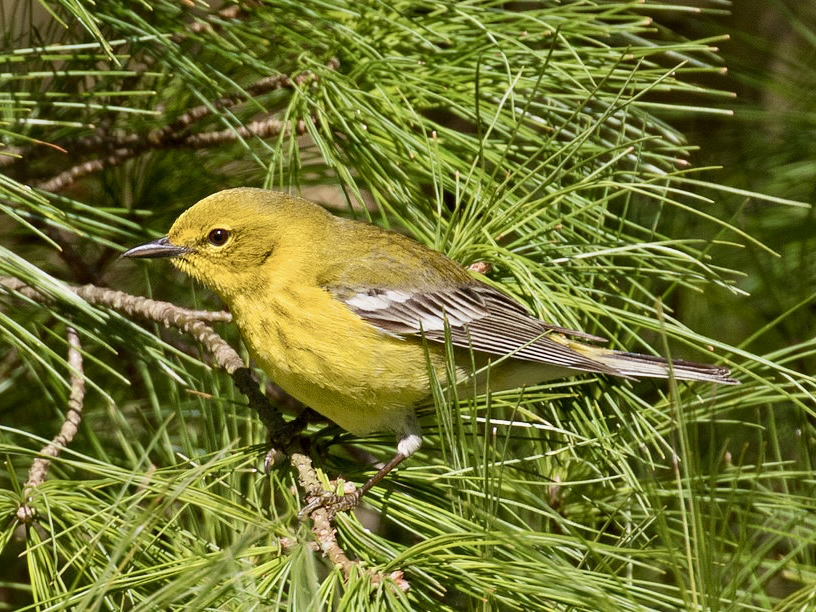
Setophaga pinus
Pine Warblers are found year-round in western NC, but they begin to sing in March. Listen for a clear, steady trill, usually coming from a pine tree.
They range in color from drab olive to bright yellow, but may be challenging to see, as they tend to forage high in the pine trees.
Look and listen for Pine warblers along the greenway, or attract them to your yard. They are one of the few warblers to eat nuts and suet.
February 2025
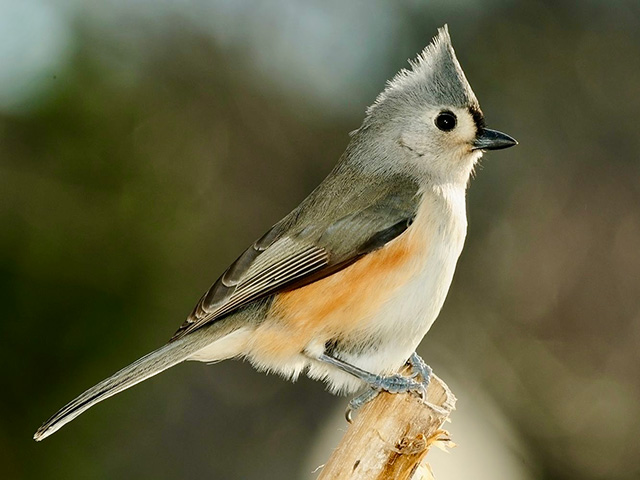
Baeolophus bicolor
The Tufted Titmouse is a small, active bird found throughout the eastern US all year. Titmice can be seen in deciduous forests, parks and back yards. Look for them along the greenway, foraging for seeds, often with other bird species.
Listen for their song which sounds like “Peter-Peter-Peter”.
Titmice will come to backyard feeders for sunflower seeds and peanuts.
January 2025
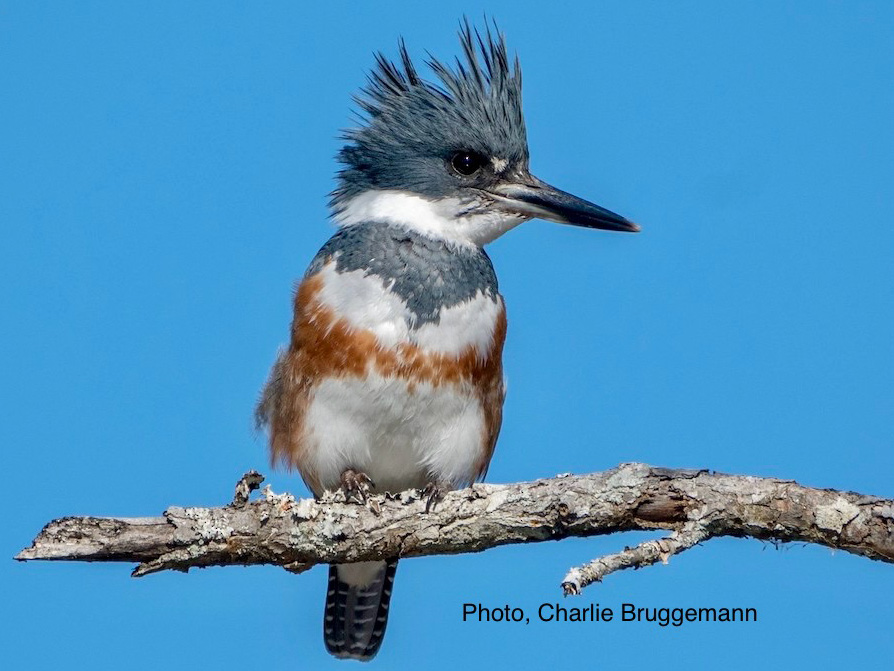
Megaceryle alcyon
Throughout much of the United States, the Belted Kingfisher is a year-round resident.
Listen for its loud, rattling call as it flies down creeks and rivers in search of small fish. The greenway is a good place to spot this bird since the path runs along the edge of the creek.
Belted Kingfishers are one of the few species in which the female is more colorful than the male. Females have a chestnut belly band, in addition to the gray breast band.
December 2024

Zonotrichia albicollis
The White-throated Sparrow is a winter resident in North Carolina, leaving its breeding grounds in Canada in the fall.
This sparrow has crisp facial markings of black, white and bright yellow.
Look for these birds along the greenway on the ground or low in the shrubs. They often respond to ‘pishing’.
You can attract White-throated Sparrows to your yard with millet and sunflower seeds, or by providing a brush pile for shelter.
November 2024
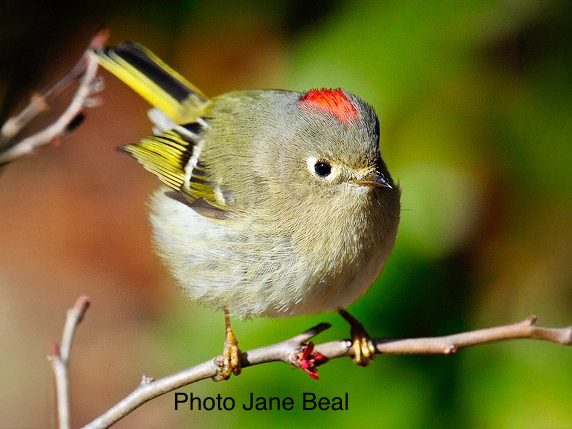
Corthylio calendula
Ruby-crowned Kinglets arrive in late fall and spend the winter in western NC. They are tiny birds, smaller than warblers and chickadees, with a huge amount of energy. Although they are common in the trees along the greenway, they may be difficult to spot. Look for an energetic bird with bold white wing bars and an eye ring. If you’re lucky, you may see a male flash its bright red crown feathers. Listen for a long, chattering series of notes.
September 2024
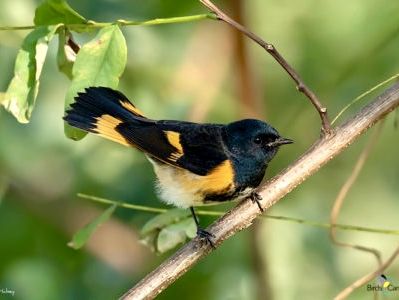
Setophaga ruticilla
September is the peak of fall migration along the greenway and the American Redstarts will be passing through, on their way to Central and South America.
They are small, active warblers which flash tail spots to startle insect prey.
Males are orange and black, while females are more subdued gray and yellow.
Look for redstarts along the path in deciduous trees and watch for their tail-flaring behavior.
August 2024
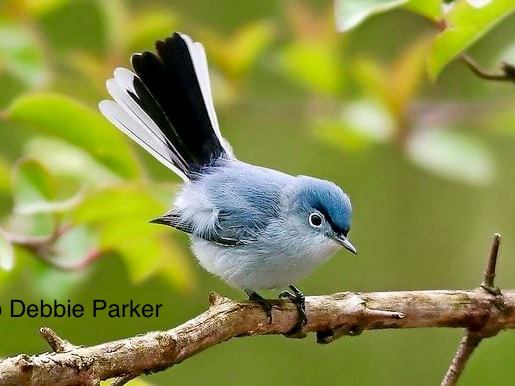
Polioptila caerulea
It may be challenging to catch a glimpse of the Blue-gray Gnatcatcher along the greenway. Although they arrive in spring and nest through the summer, gnatcatchers are tiny and active. Look for them in the branches above the path, and listen for a high-pitched buzzing song. They often flash their white outer tail feathers when feeding or defending their territory.
July 2024
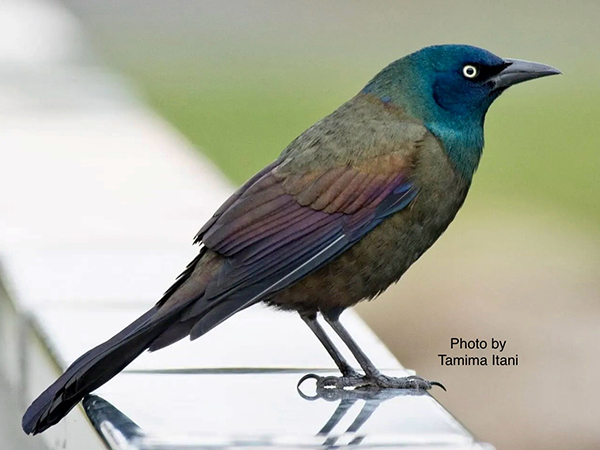
Quiscalus quiscula
Common Grackles are members of the blackbird family and can be found along the greenway in swampy areas and open fields. Males appear black overall, but in the sunlight show beautiful iridescent colors and a light eye. Females are brown overall.
Grackles may visit backyard feeders, or eat seed and grain scattered on the ground. In the fall and winter, grackles will form huge flocks with other species of blackbirds, sometimes numbering in the millions.
June 2024
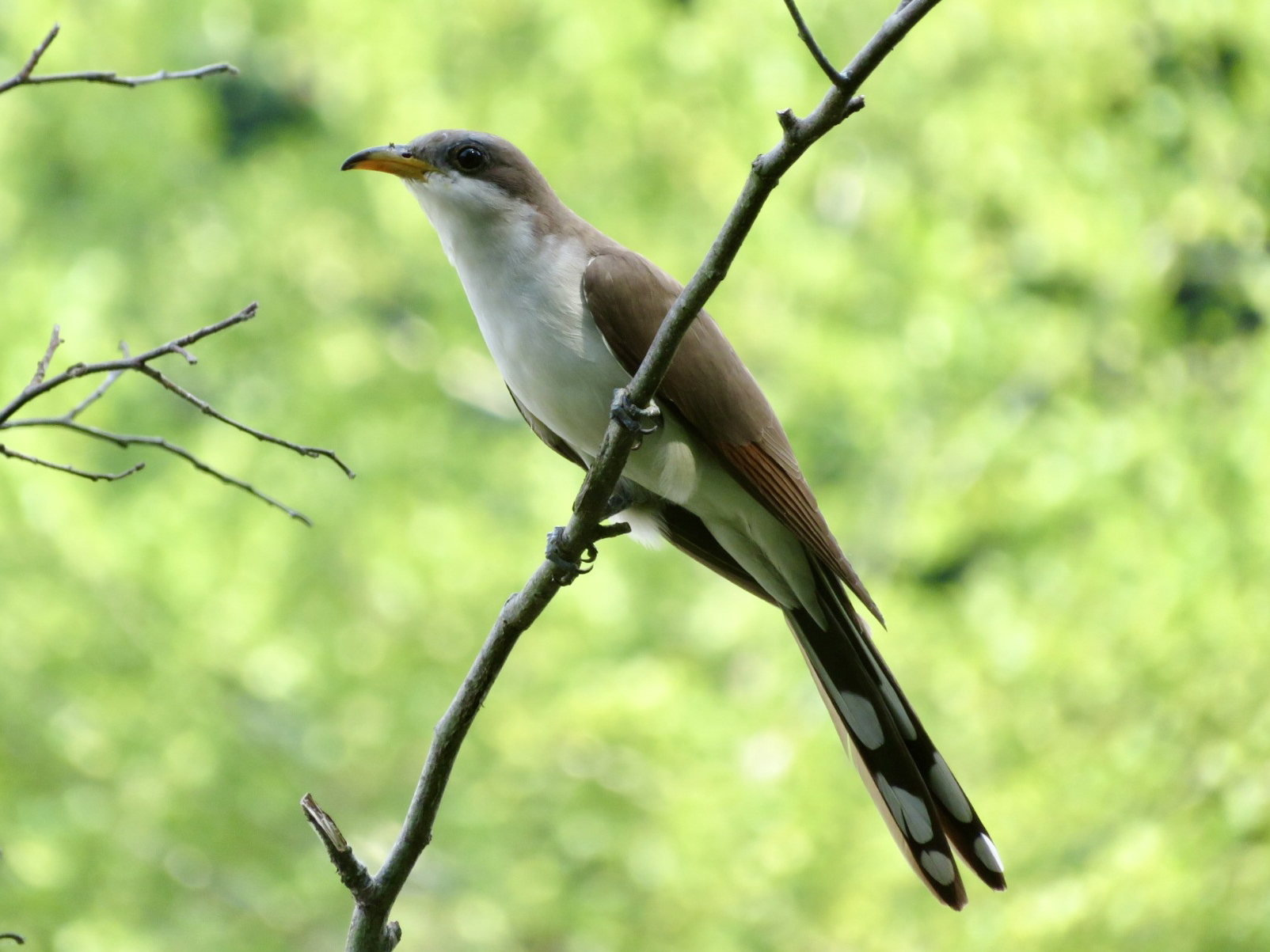
Coccyzus americanus
Yellow-billed Cuckoos have returned from South America to breed in the eastern US. Unlike the European cuckoo, our native species does not say “Cuckoo”. Instead it makes a croaking sound, which may help you locate the bird.
Cuckoos sit very still in the trees, and in flight, flash their slender rufous wings. White spots on their long tails are also help with identification.
You may find them feeding on tent caterpillars in the summer and fall.
May 2024
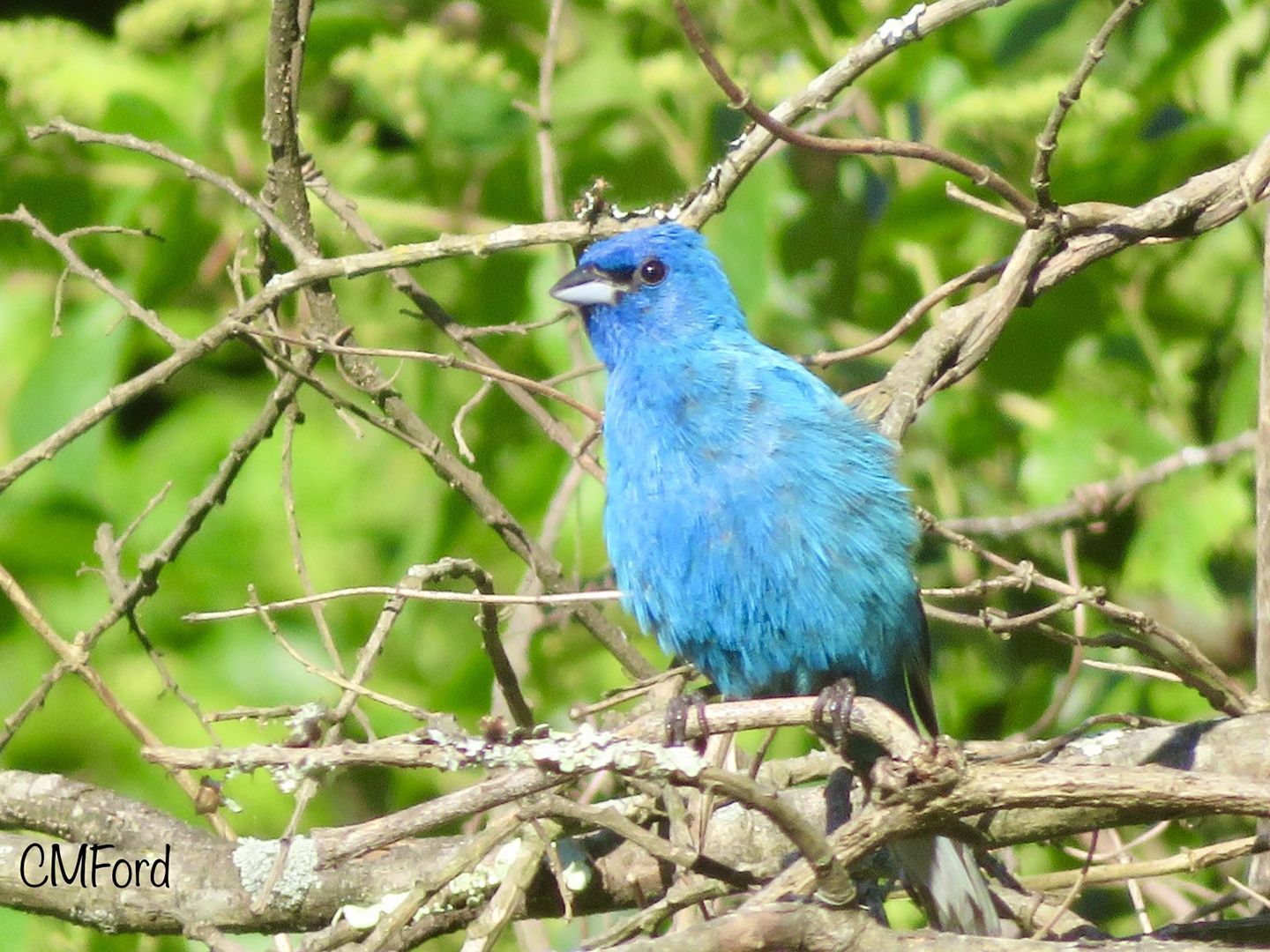
Passerina cyanea
May is a great time to look for Indigo Buntings, which are returning to the greenway from wintering in Central and South America. They breed in our area and will migrate south again in the fall.
Breeding male Indigo Buntings are bright blue, and females and non-breeding males are brown. Like all blue birds, Indigo Buntings lack blue pigment. Their color comes from structures in their feathers which reflect and refract blue light.
Look for buntings in weedy or shrubby areas. Often male buntings will sing from the tallest perch of a tree.
April 2024
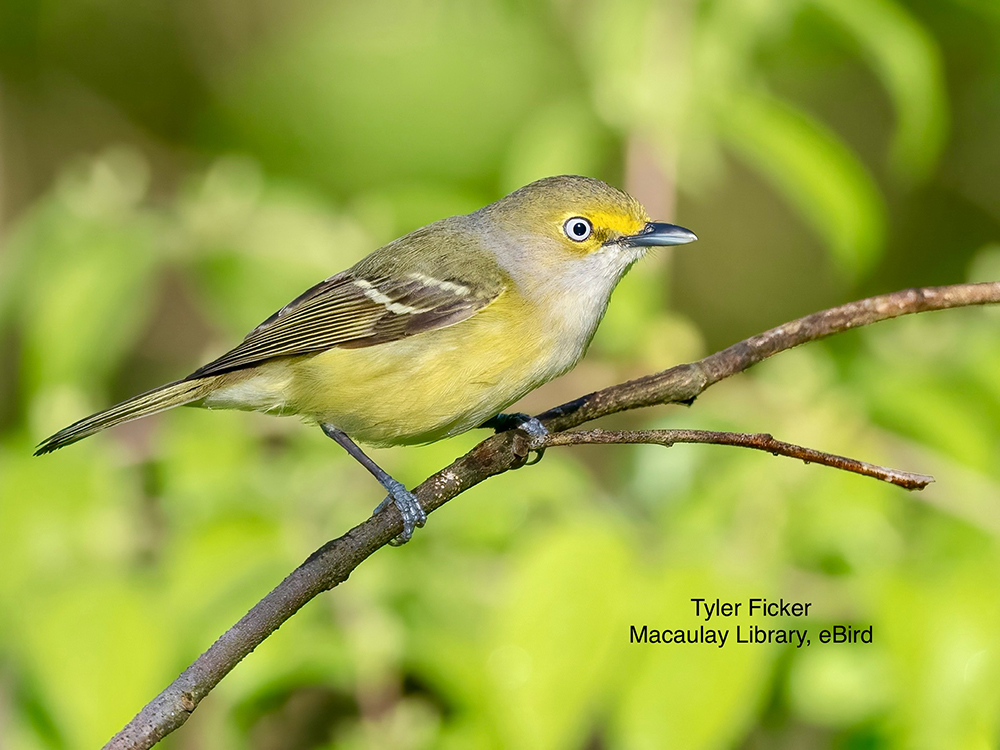
Vireo griseus
White-eyed Vireos spend the winter along the southeast coast of the US, and in the Caribbean islands, and return to our area to breed and raise their young.
April is the month to listen for White-eyed Vireos along the greenway. You’ll hear them singing from the thickets, especially along the creek, saying, “Quick, give me a rain check”.
Look for a small bird with yellow “spectacles” and flanks. If you catch a good view through the binoculars, you can see the white eye in adult birds.
March 2024
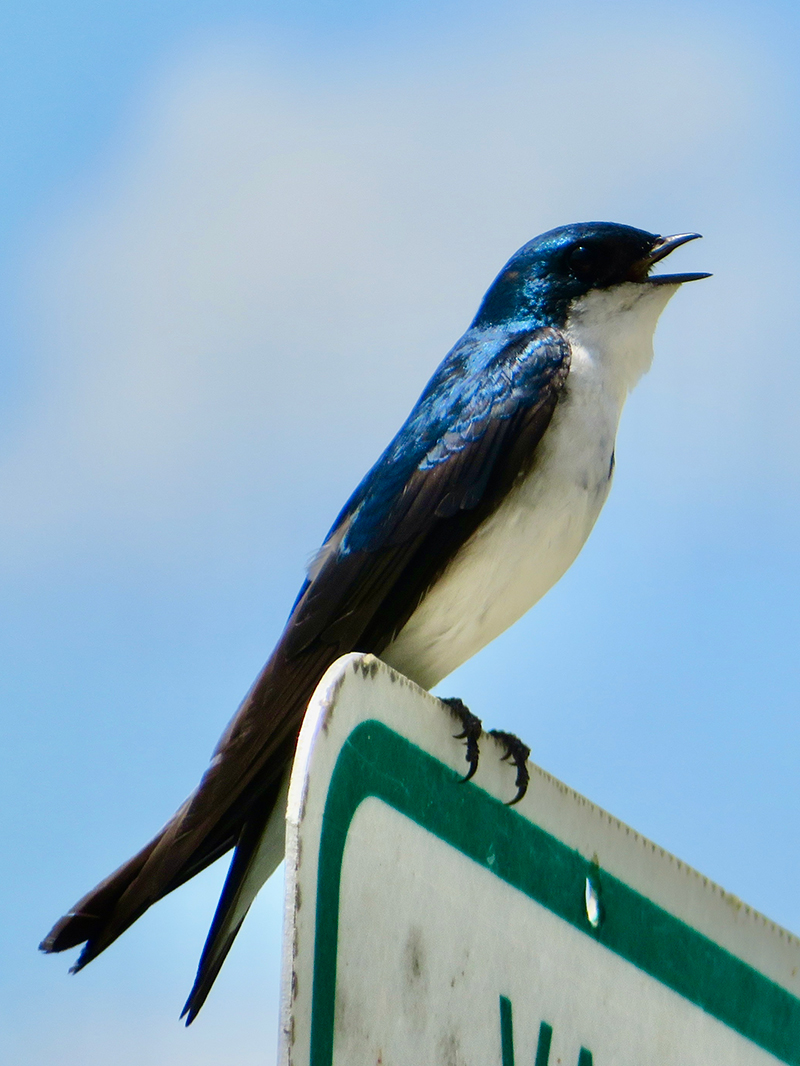
Tachycineta bicolor
Tree Swallows are one of the first birds to return to western NC from the tropics, arriving in late February.
You will usually see them over open fields or water, catching insects on the wing.
Sometimes they perch on a wire or limb.
Look for small birds with white undersides and deep blue iridescent backs.
Tree Swallows will use nesting boxes or natural tree cavities.
February 2024
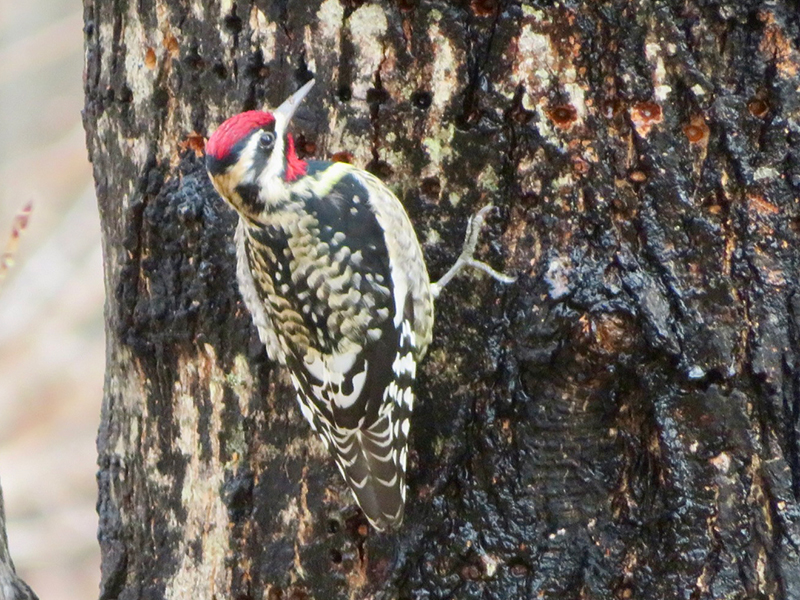
Sphyrapicus varius
The Yellow-bellied Sapsucker is a winter woodpecker in North Carolina, returning to the northern US and Canada in the spring. These woodpeckers make rings of small holes in the bark of trees, from which they drink sap.
Along the greenway, look for a black and white bird with vertical white wing patches, clinging to the trunk of a tree. Adults have a red crown and males have an additional red throat.
January 2024
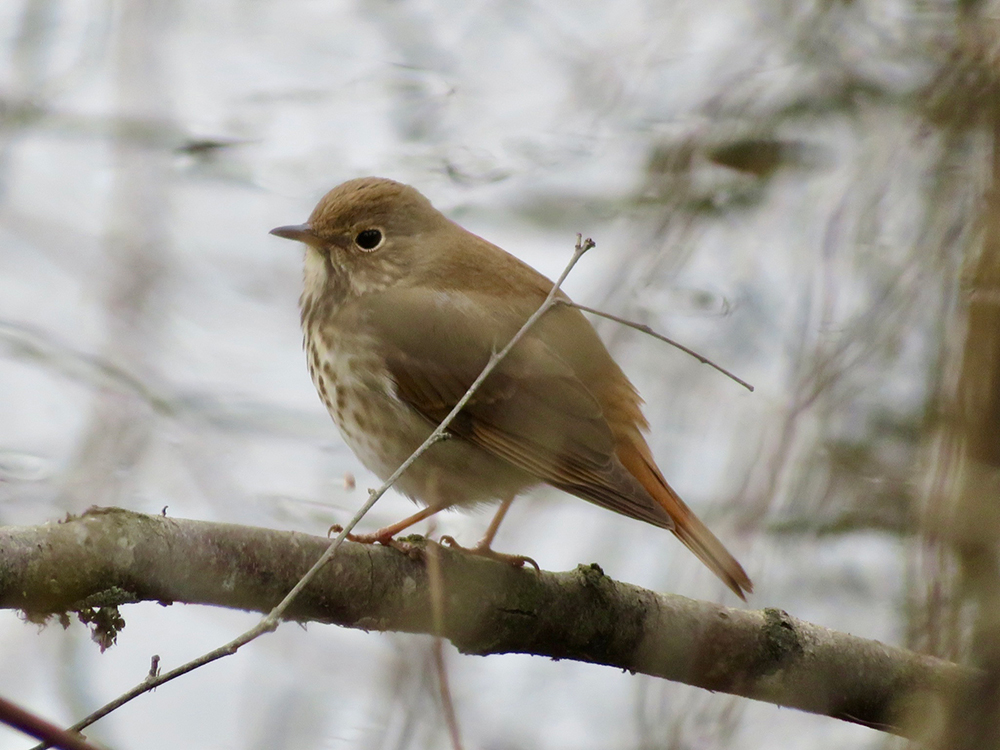
Catharus guttatus
The Hermit Thrush is a winter visitor to North Carolina, coming down from New England and Canada. This small brown bird, with a spotted breast and reddish tail, stays close to the ground at the forest edge.
Along the greenway, look for the Hermit Thrush along the path or at the edge of the woods, low to the ground. It is often found near shrubs with berries. Listen for its “chup” call.
December 2023
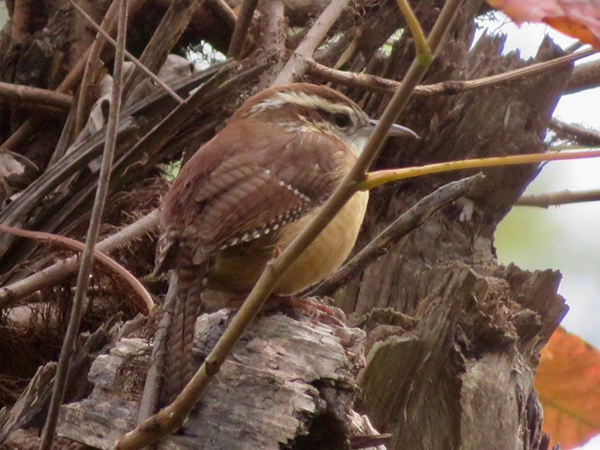
Thryothorus ludovicianus
Even if you have never seen this little woodland bird, you’ve probably heard it. The Carolina Wren has the loudest voice in the forest, singing “teakettle, teakettle”. Listen for it any time of year, as this wren is a year-round resident.
Along the greenway, the Carolina Wren can be seen mid-level in the trees, low in the thickets and along the creek. This little cinnamon colored bird will also visit backyard suet feeders in the winter.
November 2023
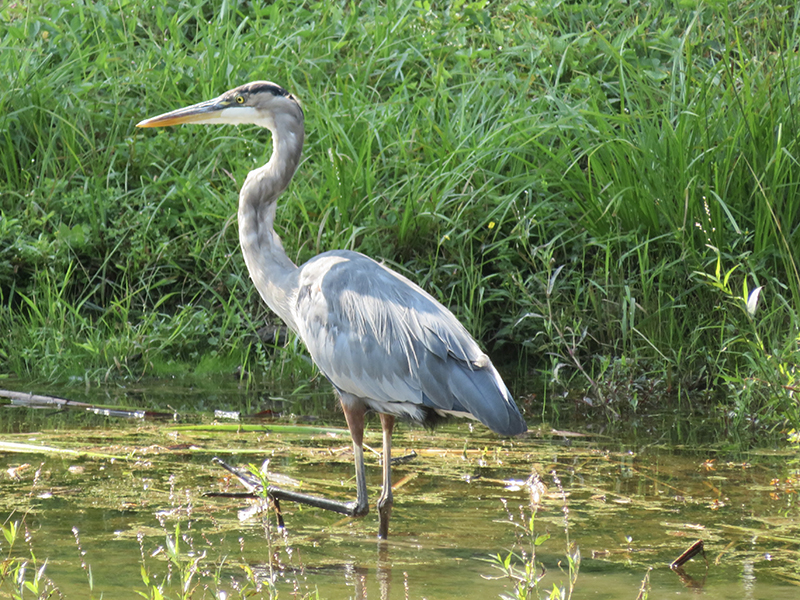
Ardea herodias
Recognized by birders and non-birders alike, the majestic Great Blue Heron is found throughout the US. Look for this bird in the wetlands or in the creek along the greenway. With long legs and a sharp bill, herons are well-adapted for fishing for aquatic animals. They will sometimes hunt for mammals on dry land as well.
Most likely you will see the blue form of this bird, but in south Florida and the Caribbean, there is a white form, known as a Great White Heron.
October 2023
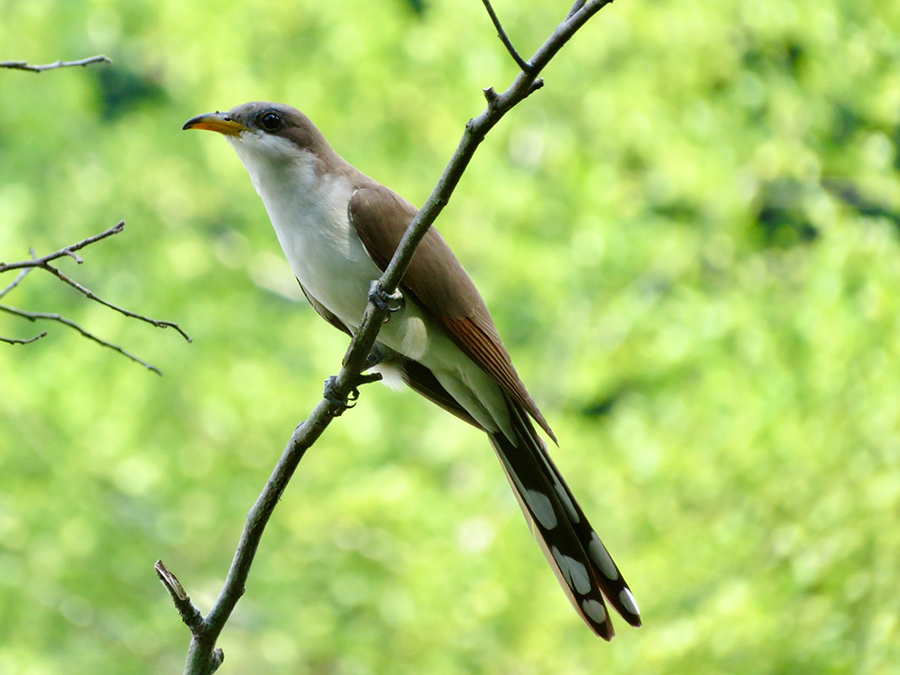
Coccyzus americanus
Yellow-billed Cuckoos breed throughout the eastern US, and by the end of October, will have migrated to South America. These slender birds move slowly through the trees, feeding on caterpillars.
One way to spot one along the Greenway is to look for tent caterpillar nests. In flight, you may notice the flash of rusty brown on their wings.
September 2023
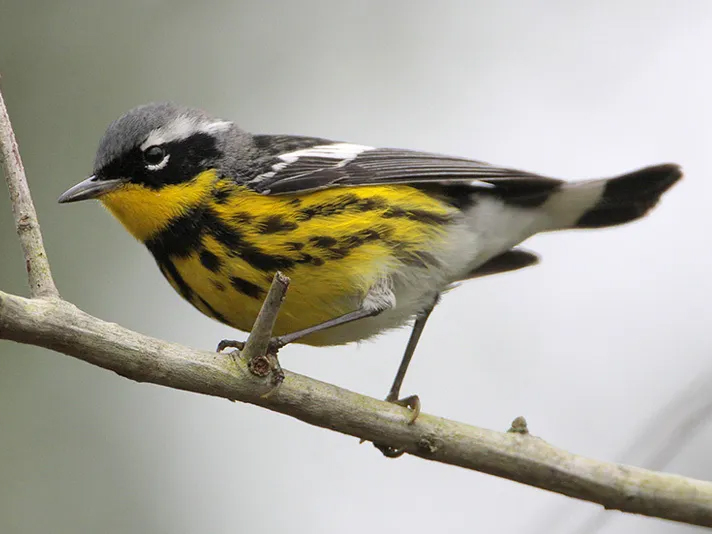
Setophaga magnolia
The Magnolia Warbler is a boreal warbler that breeds in the forests of Canada and northeastern US. During fall migration, they pass through our area on their way to Central America and the Caribbean. Like all warblers, Magnolias are very small and active, foraging in the trees. Their plumage is yellow, black and white, with a black tip on the underside of the tail. The tail “dipped in ink” is one of the best ways to identify a “Maggie” as it feeds along the greenway.
August 2023
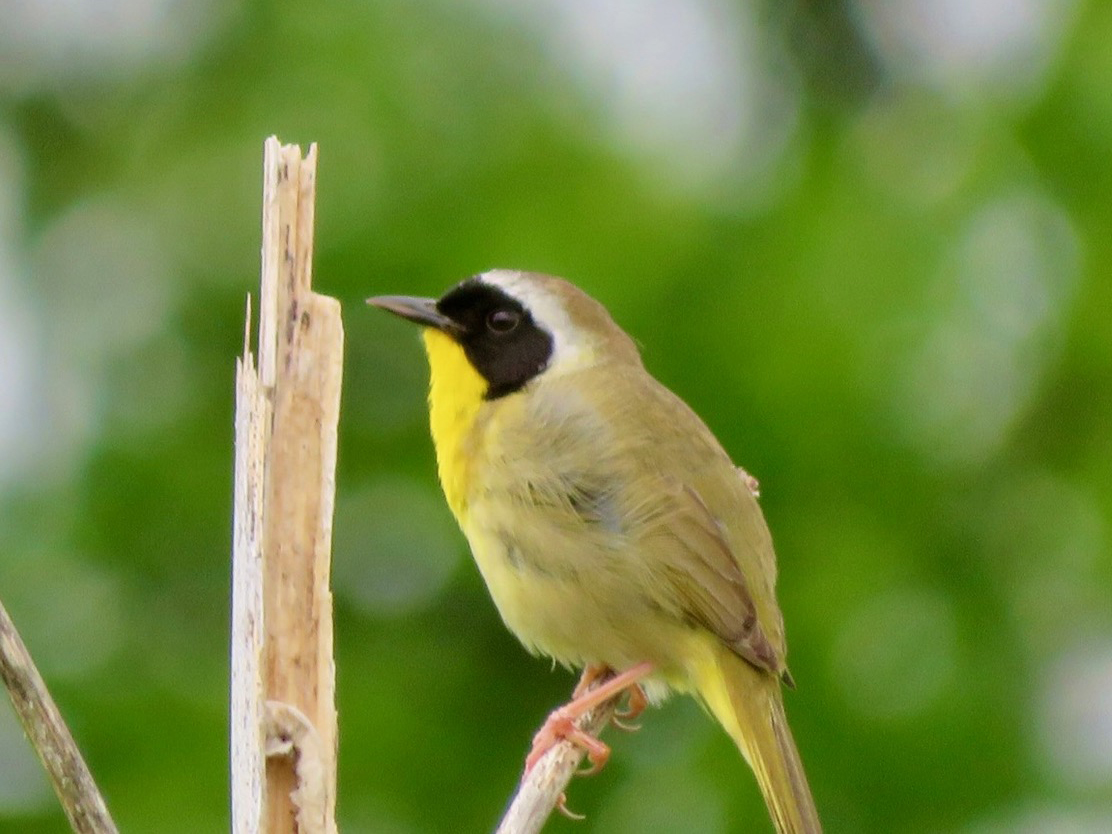
Geothlypis trichas
Warblers can be challenging to spot and identify, but the Common Yellowthroat is a regular on the greenway. In early spring they start singing “witchety, witchety” and continue to sing through summer. They will breed here, then travel south for the winter.
Look for this bird along the path, low to the ground in swampy areas. Both male and female Common Yellowthroats have a yellow throat and brownish-olive back. The male sports a black mask.
July 2023

Spinus tristis
The American Goldfinch is found throughout North America. By summertime, males are a brilliant golden yellow, which makes them easy to spot along the greenway. Look for them along the path or in open weedy fields. Goldfinches are here year round, and females and winter males are a dull yellow.
You can attract goldfinches to your yard by putting up seed feeders, or planting native wildflowers such as sunflowers and thistle.
June 2023
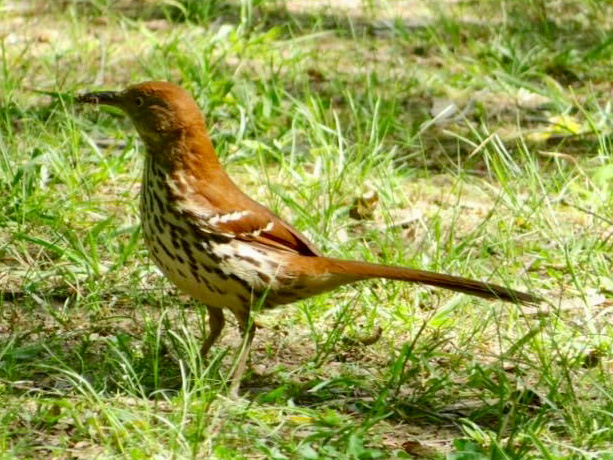
Toxostoma rufum
Brown Thrashers are found throughout the eastern US and live in North Carolina year-round. They belong to the same family as Northern Mockingbirds and Gray Catbirds, all of which mimic other songs and sounds. They can be found in similar habitat, thick shrubs and vines near the ground.
With reddish brown above and streaks below, these birds can sometimes be seen on the greenway path or in nearby shrubs. Listen for a series of songs that they copy from other bird species.
May 2023
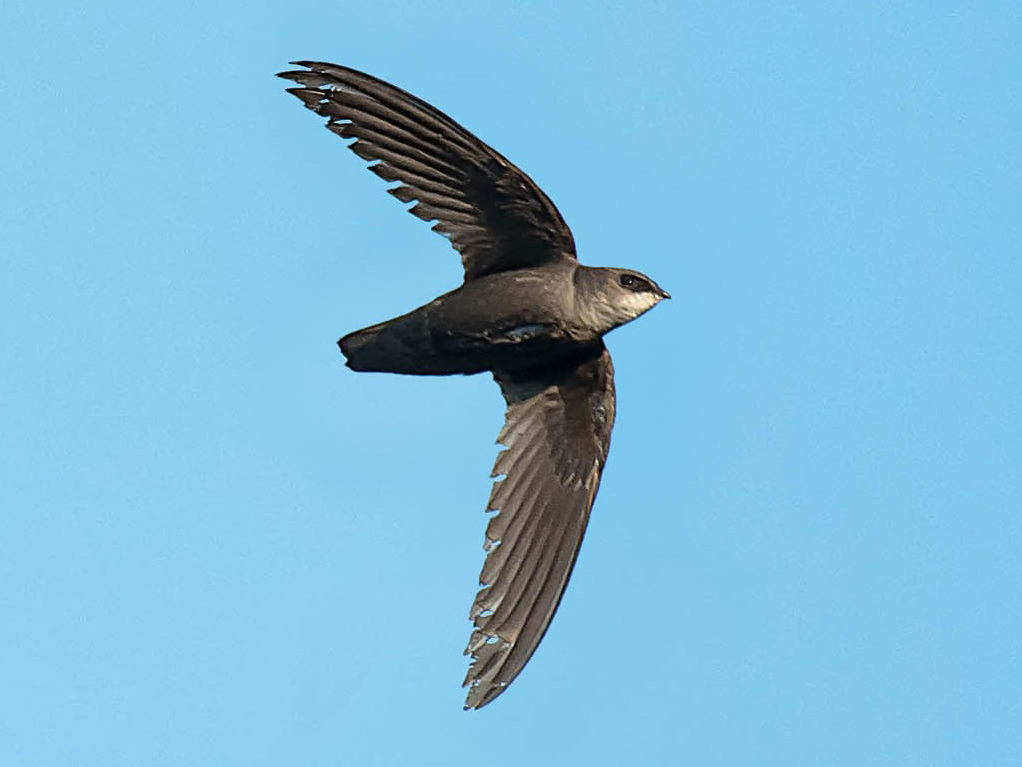
Chaetura pelagica
Chimney Swifts arrive in the spring and stay in our area all summer to breed. To spot a Chimney Swift on the greenway, you will need to find an open patch of sky, and look for it'92s small silhouette. Chimney Swifts cannot perch, and spend their time on the wing, or clinging to the insides of chimneys.
Look for a small bird with a cigar shaped body and long pointed wings. Listen for their high-pitched chattering as they feed in the air.
April 2023
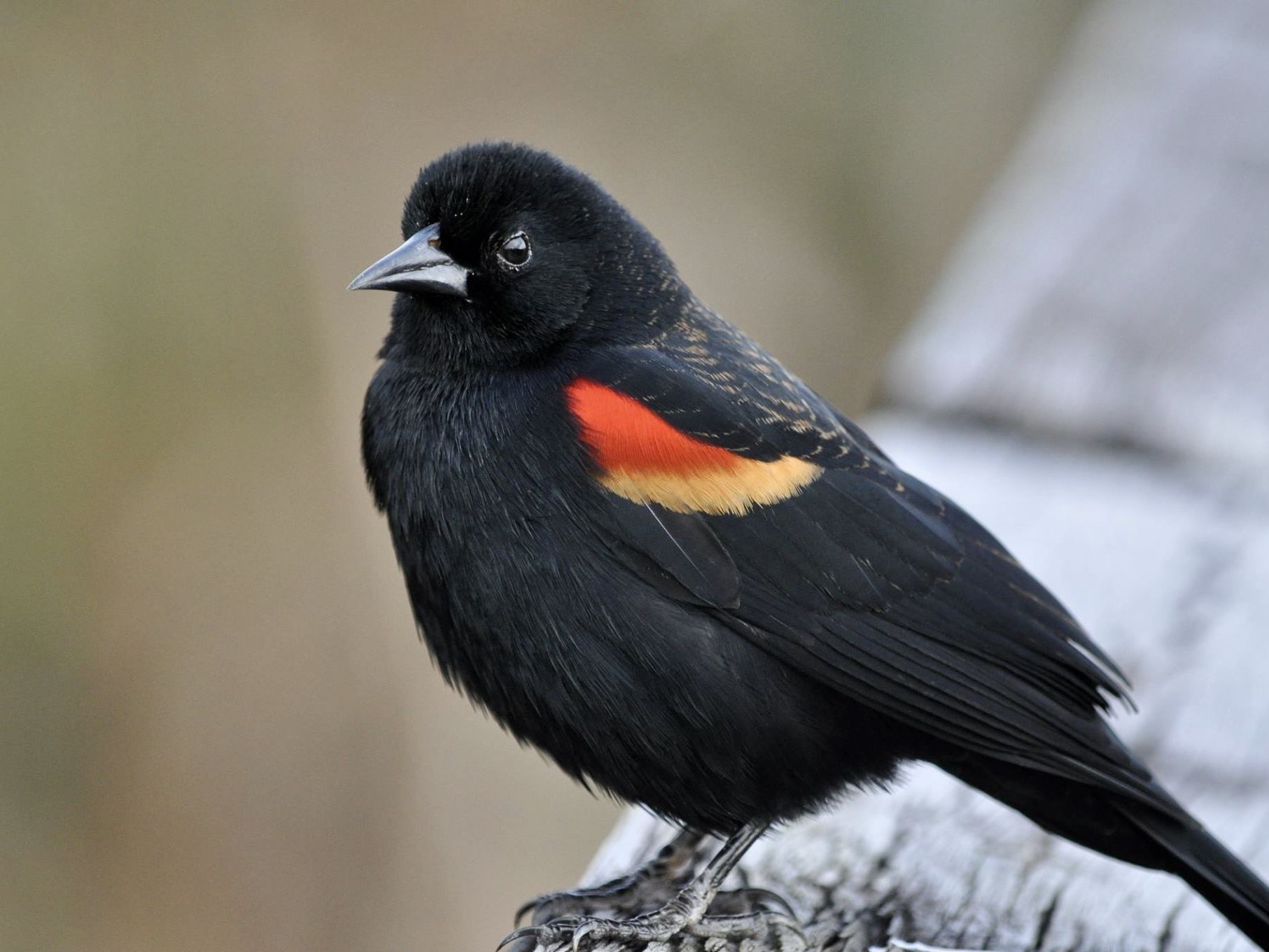
Agelaius phoeniceus
Red-winged Blackbirds occur throughout North America and are especially active and vocal along the greenway in spring. The males are glossy black with bright red and yellow shoulder patches, which they can puff up. Females are subdued with brown streaks and an orange tinge to their faces.
On the greenway, look for Red-winged Blackbirds in wetland areas such as cattail marshes, and listen for their call, “conk-la-lee”.
March 2023
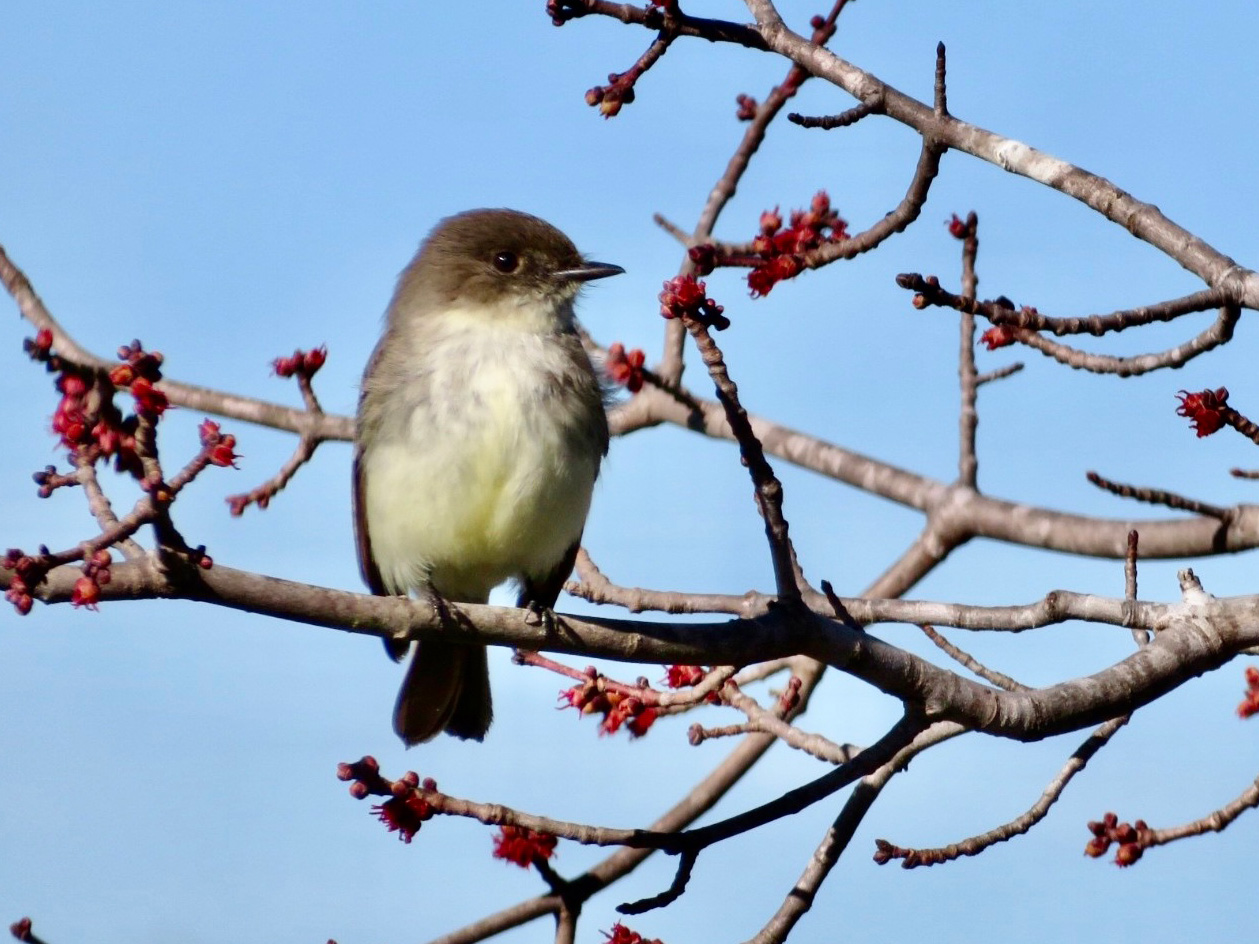
Sayornis phoebe
Like our other year round birds, the Eastern Phoebe becomes more visible and vocal in the spring. Listen for its call, “Phoebe”.
Phoebes sit upright on a branch and wag their tails. They are flycatchers, so watch for them taking flight, catching insects, and often returning to the same perch.
February 2023
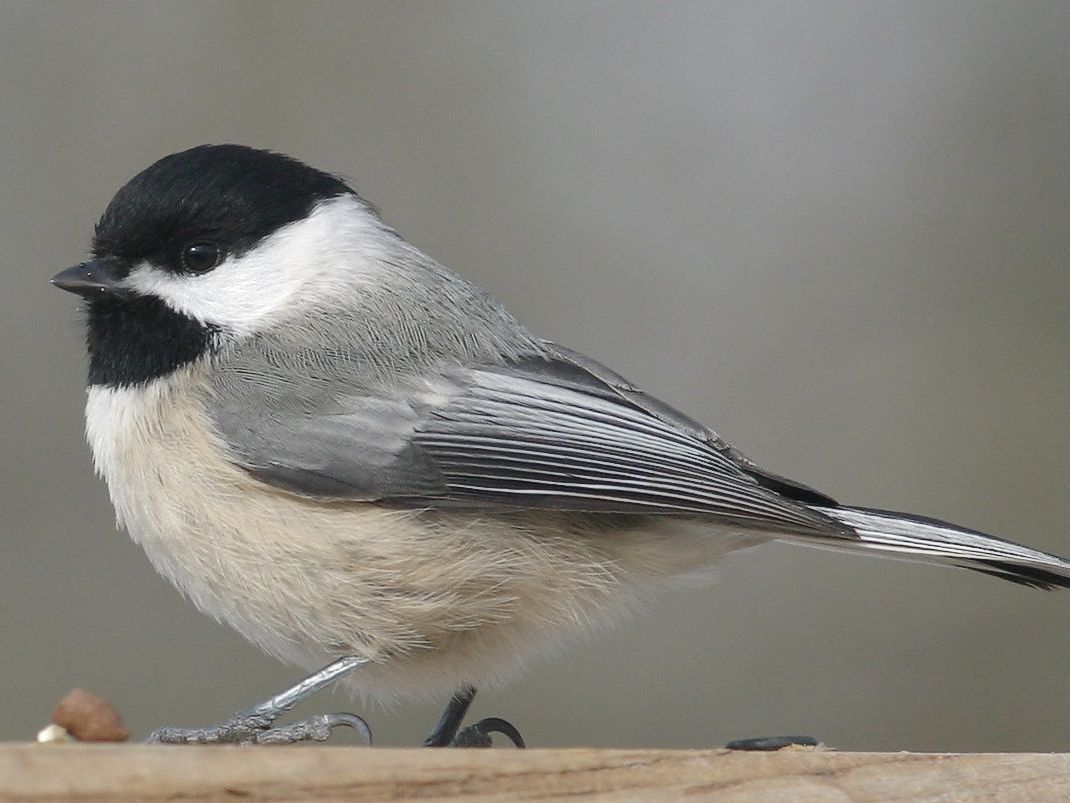
Poecile carolinensis
The Carolina Chickadee is found year round throughout the southeastern United States, and can be seen in all seasons on the greenway. Look for a small bird with a black cap and throat in the woods along the walking path. During spring and fall migration, listen for its “chick-a-dee-dee-dee” call, which may alert you to migrating warblers, with which they often associate.
Carolina Chickadees frequently come to backyard feeders for seed and suet. They may use nesting boxes, such as the ones built for bluebirds, that have been placed in yards and farm fields.
January 2023

Anas platyrhyncos
Unlike other ducks which move down from the north in the winter, Mallards are here in western NC year round. Usually found in pairs, Mallards are recognized by the male’s iridescent green head. Females are brownish overall for camouflage and may have a brood of ducklings in the spring.
Mallards occur throughout North America and Eurasia. Look for Mallards in the creek or wetland areas off the greenway path.
December 2022
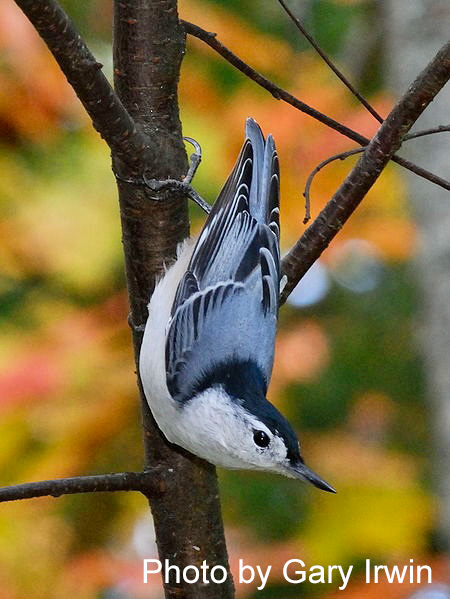
Sitta carolinensis
The White-breasted Nuthatch is found year round in western North Carolina and throughout much of the United States. Look for it on the greenway on large tree trunks and branches, with its gray back, black cap, and large bill.
Although it is a small bird, it has a loud nasal honk and a unique style of foraging. Nuthatches have the ability to hang upside down and walk down tree trunks.
You can attract White-breasted Nuthatches to your feeders by providing seed and suet.
November 2022

Turdus migratorius
The American Robin is one of our most recognizable birds, occurring in forests as well as back yards. Robins are here in western NC year round, and feed on berries as well as worms.
Along the greenway, you may see a single bird, or large flocks in the Fall. Males and females have similar coloration, with males being slightly brighter. Robins have a dark head and back, and rusty “red” breast.
October 2022
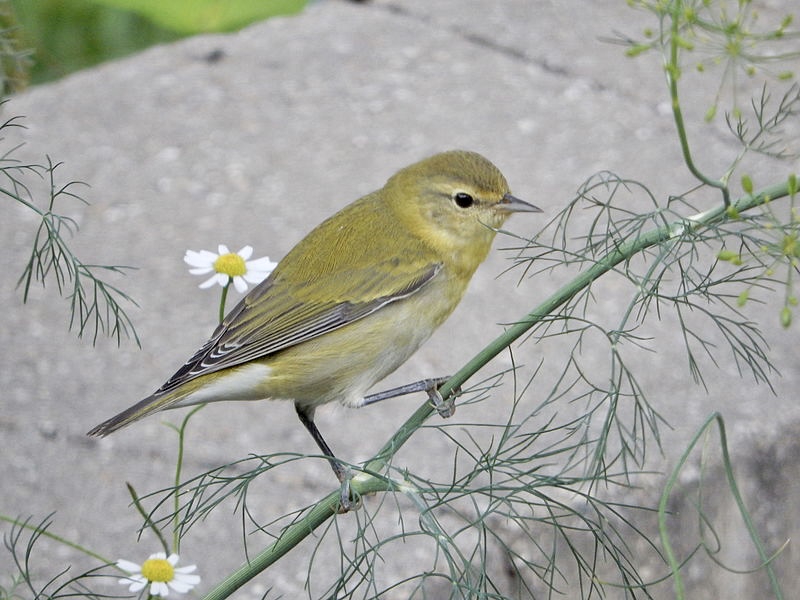
Leiothlypis peregrina
Tennessee Warblers pass through western North Carolina during spring and fall migration. In the fall they appear in larger numbers than in spring, and linger a little longer than other warbler species. Tennessee Warblers spend the winter in the Caribbean and Central and South America.
Warblers, in general, are tiny and active, making them challenging to see and identify. Look for a small, yellow-green bird with a pointy bill, and a streak through the eye. They may be seen foraging in the tall wildflowers such as those in the memorial garden near the kiosk.
Photo by Brian Plunkett
September 2022

Archilochus colubris
Ruby-throated Hummingbirds have been in our area since April, building nests and raising their young. By September they are actively feeding and preparing to migrate to South Florida and Central America for the winter.
Look for very small, hovering birds feeding on the nectar of the wildflowers on the greenway. You may notice the male’s brilliant red throat when it catches the sunlight.
You can attract Ruby-throated Hummingbirds to your yard by planting wildflowers such as Scarlet Bee Balm and Cardinal Flower. They will also visit feeders that provide sugar water. Mix one part table sugar with four parts water. Red dye is not necessary.
August 2022
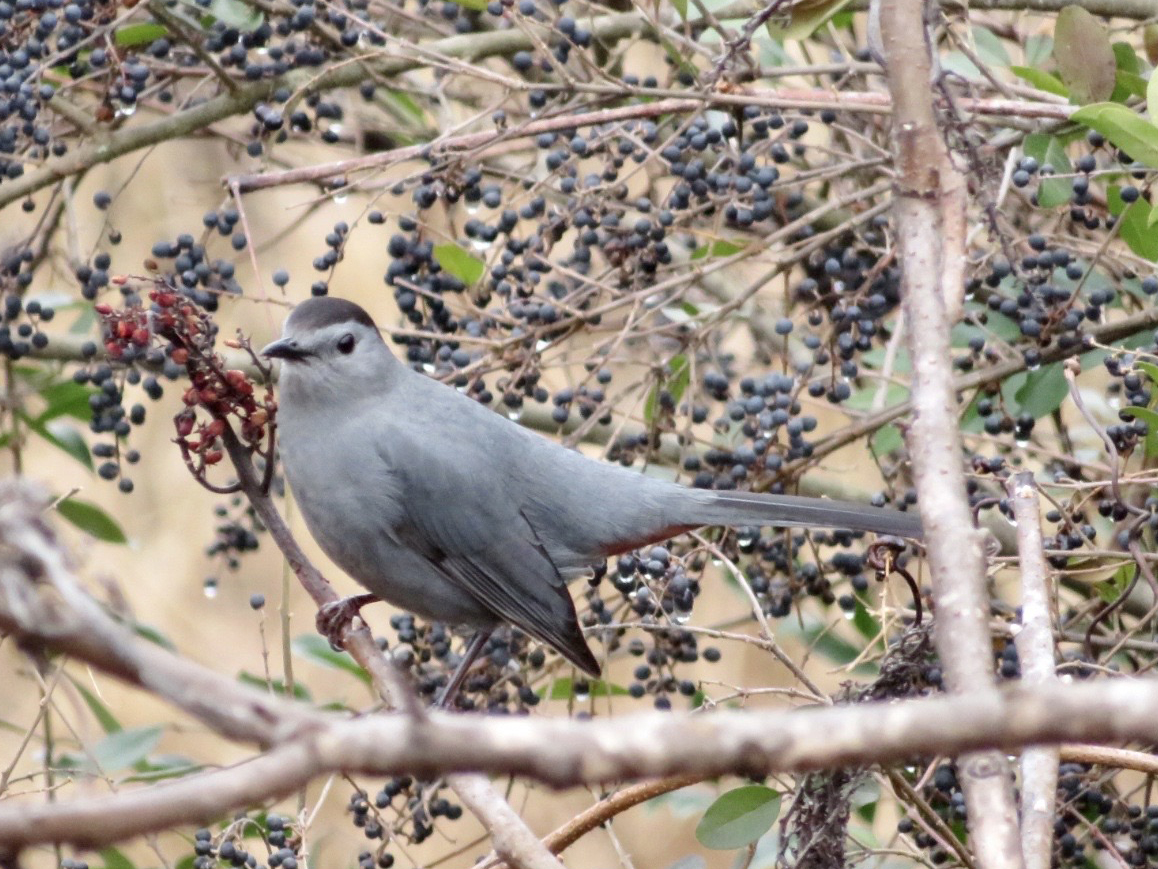
Dumatella carolinensis
You may spot a Gray Catbird along the greenway after hearing its distinctive call, like the mew of a cat. Catbirds belong to the same family as mockingbirds and have the ability to mimic sounds.
Gray Catbirds breed in western NC in the summertime. Look for a dark gray bird with a black cap in the dense thickets. You can attract catbirds to your yard by planting native shrubs with berries.
Gray Catbirds are rare here in the winter, but a few have been spotted in our local parks during the annual Christmas Bird Count.
July 2022
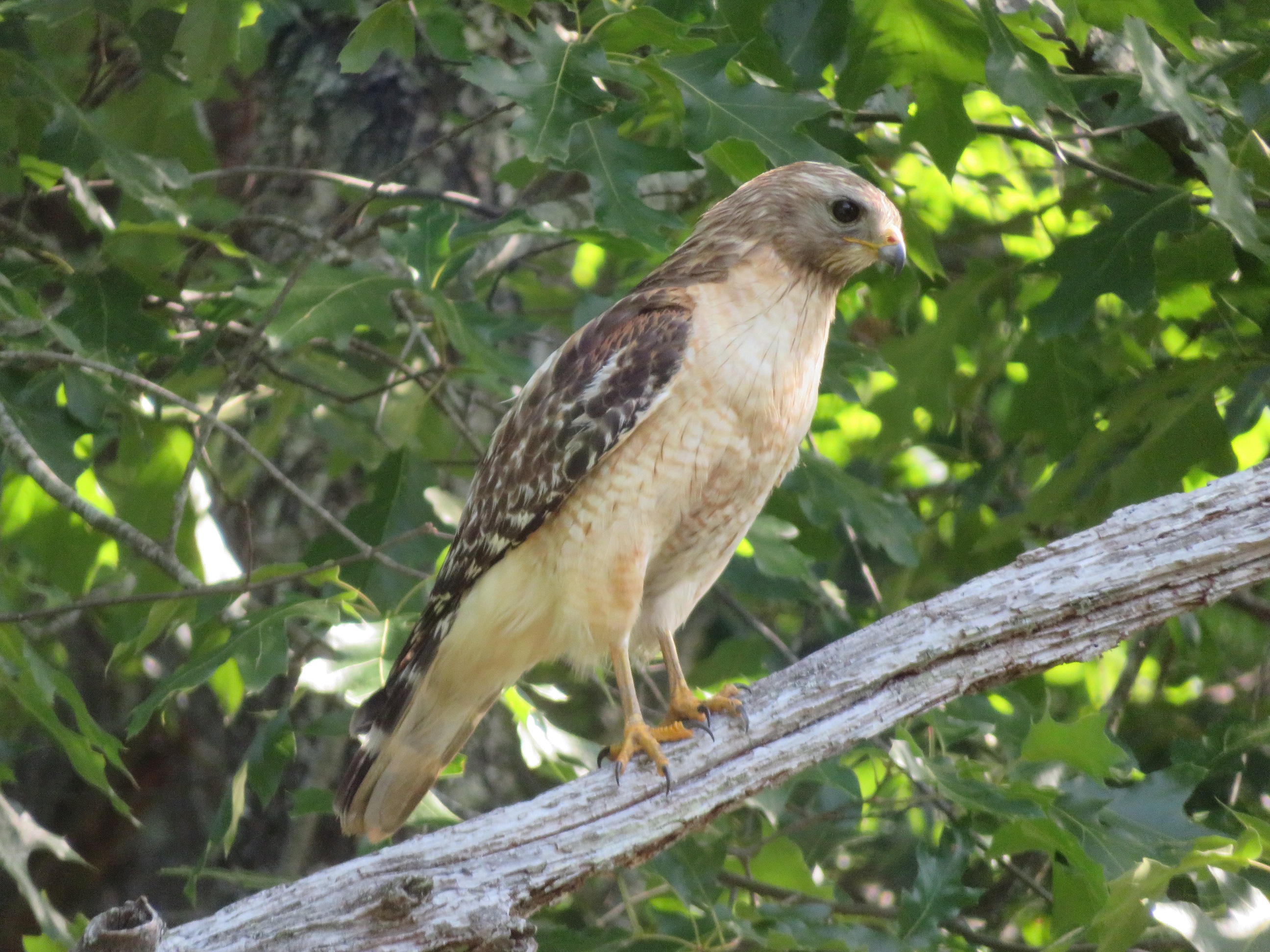
Buteo lineatus
The Red-shouldered Hawk is a forest hawk which lives in much of the southeastern US year-round. It hunts small mammals, reptiles and amphibians in the woods around the waters edge.
The adult hawk is identified by its orange or peachy-colored breast and strongly banded tail. It also has red shoulder patches which can sometimes be visible when the bird is resting or in flight.
Listen for the Red-shouldered Hawk calling while at rest or in flight, as it is a very vocal bird of prey.
June 2022
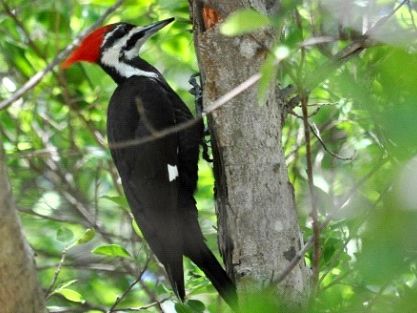
Dryocopus pileatus
A year-round resident to much of the eastern US, the Pileated Woodpecker is our largest woodpecker in the area. Listen for it calling or pecking on large trees.
Pileated Woodpeckers are about the size of crows, with black and white plumage and a striking red crest.
These woodpeckers are cavity nesters and excavate holes in large dead trees. For this reason, dead trees are often left on the greenway to provide sources of food and nest cavities.
May 2022
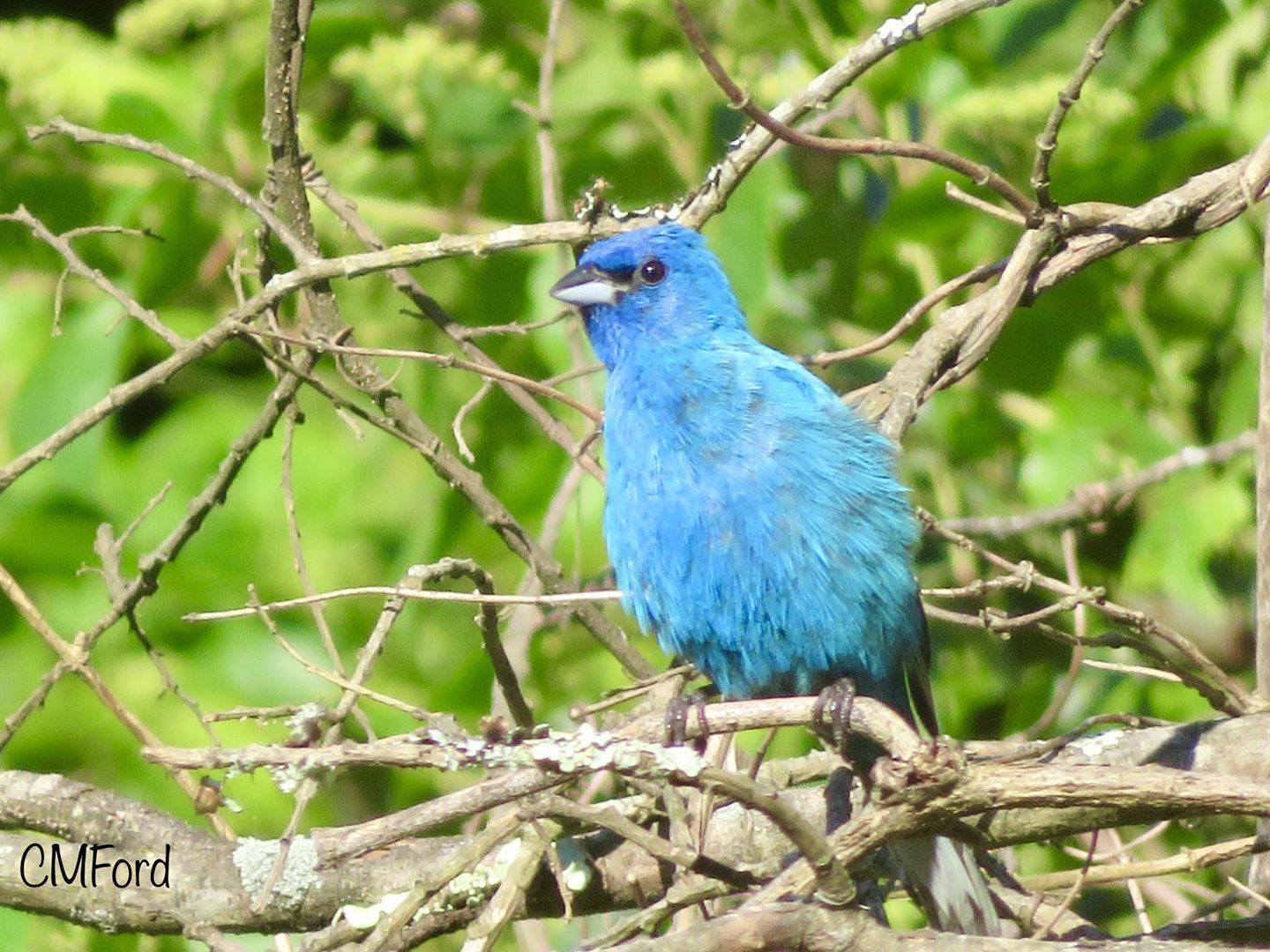
Passerina cyanea
Indigo Buntings are returning to the greenway from wintering in Central and South America. They breed in our area and will migrate south again in the fall.
Breeding male Indigo Buntings are bright blue, and females and non-breeding males are brown. Like all blue birds, Indigo Buntings lack blue pigment. Their color comes from structures in their feathers which reflect and refract blue light.
Look for buntings in weedy or shrubby areas. Often male buntings will sing from the tallest perch of a tree.
April 2022
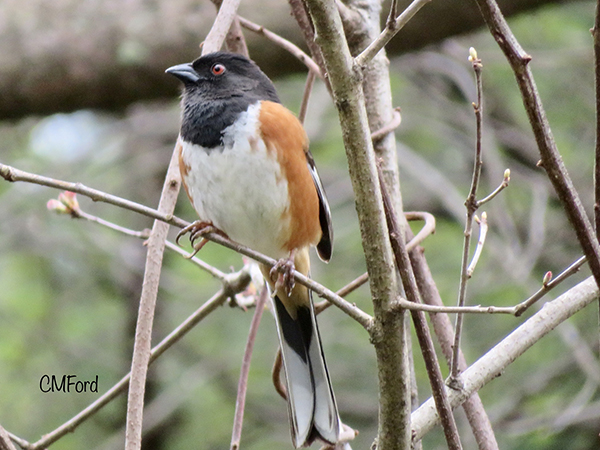
Pipilo erythrophthalmus
The Eastern Towhee is a large, brightly colored sparrow that can be found on the greenway, usually scratching on the ground in the leaf litter.
At this time of year, the males sing “Drink your tea”, and at other times call “Tow - hee”.
Males are boldly patterned with black above, orange flanks and a white underbelly. Females have a warm brown color instead of the black.
Towhees are found on the greenway year-round but are especially vocal this time of year.
March 2022
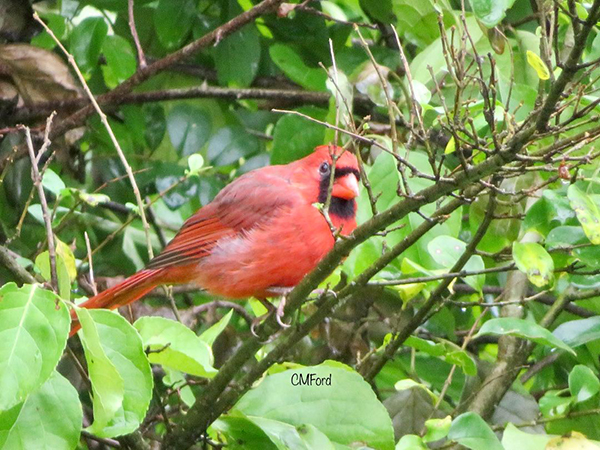
Cardinalis cardinalis
The bright red male Northern Cardinal is one of the most recognizable birds.
Cardinals don’t migrate and are therefore found on the greenway year-round.
Adult cardinals don’t molt their feathers so the males remain bright red all year. The females are a warm brown with red accents.
Look for cardinals foraging on the ground or perched in the trees, singing.